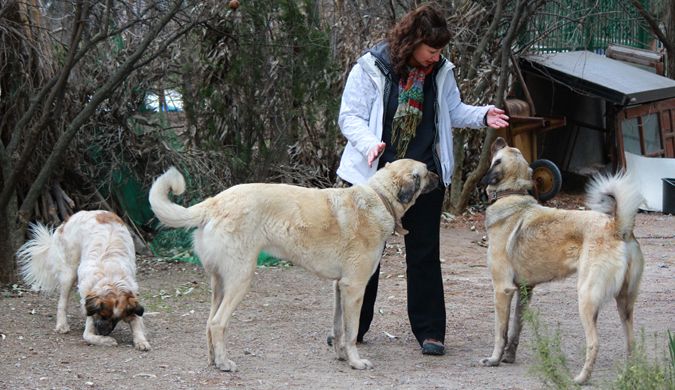
Updated: 12/24/2018 | December 24th, 2018
A lot of readers were interested in learning more about house-sitting (watching people’s houses while they’re away in exchange for free accommodation). I’ve never done it, but Dalene and Pete from Hecktic Travels do it all the time, so I brought them in to talk more about the subject. Enjoy!
As I write this, I’m sitting in a comfortable leather recliner in front of three large bay windows. In my view are tall pines covered in healthy green moss, as well as shimmering water from a nearby lake. An old, chubby gray cat — the king of this log cabin — warms my feet.
This is my home for three months, and my husband and I are living here for free. We pay no rent or utilities, and we have a vehicle at our disposal.
We are house-sitting.
We travel around the world taking care of pets and homes while their owners are off on their own travels. Not only does it keep our costs extremely low but it also gives us an intimate experience in a new locale and complete immersion in the neighborhood.
The majority of our last three years traveling have been spent house-sitting, saving us well over $30,000 in accommodation costs and affording us an incredible set of travel experiences we might never had enjoyed otherwise.
But this way of travel isn’t just for long-term nomads like us; opportunities are available for all types of travelers. House-sitting jobs range from weekends to years in length; our shortest house-sit was nine days and our longest was six months.
Why Become a House Sitter

The benefits don’t stop at the savings on accommodations! The worldwide house-sitting community is full of like-minded travelers and adorable pets. We’ve made lifelong friends with eight dogs, nine cats, four chickens, and sixteen humans (homeowners). It is by far our preferred method of traveling for many reasons:
We can travel at a slow pace. Spending only a few days in every city on the prescribed tourist trail may seem like a great way to see the world, but taking on a house-sitting job will give you an entirely different experience and allow you to catch your breath while on the road. Try actually unpacking for once, making your own coffee in the morning just the way you like it, and cuddling up with pets at the end of the day. It’s like being at home, while away.
More savings! Not only will you save big bucks by slashing your accommodation expenses but you will also cut your food budget by cooking for yourself. Start your day with breakfast and lunch at home and pocket those savings or splurge on a big dinner! (Just make sure to schedule your outings around the pet’s schedule.)
Plus, if you’re considering a move, finding a house-sitting opportunity in your desired location will help you really get a feel for what it might be like to live there.
How to Become a House Sitter

If you’ve never been house-sitting before, the best place to start is with your own connections. Query family, friends, and colleagues about opportunities. Chances are good that someone in your network will be away from home soon. House-sit for them to learn the ropes. With at least one good house-sitting reference under your belt, you’ll have a better shot at convincing a stranger across the world that you’re worthy of their trust.
Homeowners are looking for responsible people to help reduce their own costs (pet kennels are expensive!) and to keep their house safe and in order while they are gone.
1. Sign Up with a House Sitting Website
There are several good house-sitting websites out there to match with homeowners and find good house-sitting jobs (all have membership fees). Here are the best house sitting websites on the net:
- Nomador.com (free or $89 USD annual fee) – Nomador has the highest number of house-sits in Europe and is growing worldwide. Its unique “trust profiles” help lay a foundation of trust between homeowners and house-sitters. In addition, it has an exciting “Stopovers” feature, which is similar to Couchsurfing.
- TrustedHousesitters.com ($130 USD annual fee) – This site is heavy on UK and European house-sits but is also gaining ground in Australia and North America.
- MindMyHouse.com ($20 USD annual fee) – Low fee to join, a good number of house-sits (primarily in North America and Europe), and a well laid-out website.
- Housecarers.com ($50 USD annual fee) – Plenty of good house-sits, with a focus on Australia, New Zealand, and North America, but a poor website structure makes it difficult to navigate.
When reviewing available house-sitting jobs on the above websites, choose jobs carefully according to your own desires in terms of location, timing, and other needs. The key to finding one is flexibility in your plans: rather than searching for a house-sit in north London for the first week of August, widening your search to all of London and for a week during any time of the month will increase your chances greatly.
Once you’ve seen some house-sitting opportunities that are right up your alley, be sure to have these basics in place:
2. Create a killer house-sitting profile – This is your face to homeowners, and if it is well written and up-to-date, you may have homeowners contacting you directly rather than posting their house-sitting job. Things to include:
- Experience, as a house-sitter or as a previous homeowner (do you know your way around basic house appliances?)
- Pets: Exude your love for all things furry, or scaly, or slimy, if applicable. The large majority of house-sits include pet care of some kind.
- Special skills: Do you speak foreign languages? Do you have a green thumb, or are you handy with tools? Be sure to outline those in your profile.
- Enthusiasm: Lots and lots of enthusiasm for this newfound “career” goes a long way.
3. Write an introductory message – When applying for a specific house-sitting job, each website lets you include a message that will accompany your profile when it’s sent to the prospective homeowner. The key to a good introduction is brevity while highlighting important information — and of course, lots of enthusiasm.
Pay close attention to the listing and draft your email according to the job’s specific details. For example, if the homeowners have a dog, make a comment on how cute he is and that Schnauzers are your favorite creatures on four legs. If they have a large yard that may need your attention, mention your agility and strength and highlight how you can easily get the work done!
4. Be speedy – When the six-week house-sit opportunity in Manhattan was posted, I applied within the first few minutes of it going live. I had exchanged emails with the homeowner within the first hour and shared a virtual handshake over Skype within a day. Attractive house-sitting jobs go very fast. Being one of the first to apply can greatly increase your chances of getting it. Sign up for email alerts in your desired areas, or follow along on social media to be one of the first to know what’s available.
5. Have references – The most important thing that homeowners will look at is your references. A house-sitting arrangement between strangers requires a high level of trust, and having quality people lined up to vouch for you is important. If you have no previous house-sitting experience, consider asking the following for references: former landlords, old neighbors or bosses, or anyone who can attest to your character, reliability, and trustworthiness.

One good reference leads to another job and another good reference. And once these start to stack up, potential homeowners will be highly inclined to work with you, and subsequent house-sitting jobs will be much easier to get. While all of the house-sitting websites house references online, you should also compile them yourself and have them ready to distribute.
6. Expect an interview – If the homeowner doesn’t ask for one, I insist that you do. In the beginning, it’s easy to get overly excited about the prospect of living somewhere exotic for virtually free and forget about the finer details of the job. So use Skype to have some (virtual) face-to-face time and get a good feel for each other. Be sure to ask a lot of questions; leave nothing left unknown: Can you have guests? Can you leave the property overnight to explore a nearby area? Is there a vehicle available for your use? How is the Wi-Fi connection? You don’t want to be blindsided with rules or surprises when you arrive. And trust your gut: we have said no to house-sitting jobs before because the vibe wasn’t right with the homeowners.
How to Be a Good House Sitter

There’s no question about it: house-sitting needs to be taken seriously. In exchange for a free place to stay, you’re being asked to take care of someone’s worldly possessions and perhaps their beloved fur (or feathered) babies.
We’ve chased dogs through muddy fields (and disposed of a half-eaten rat courtesy of same). We have spent an evening trolling through dark alleys in Harlem, looking for an escaped fat cat. We dealt with a dead chicken by “sending it down the river” on the advice of a neighbor in Ireland. We’ve cleaned up after torrential rain hammered our temporary Caribbean house. Most times you’ll be able to kick back and soak up your good fortune, but there will be moments when you will have to work for it.
The key to getting a repeated number of house-sits is to do an excellent job each time and stack up virtuous references.
For starters, make sure you show up! When a commitment is made, it is up to you to keep it. Homeowners make important travel plans based on having someone to care for their house and pets — they are counting on you!
On arrival, treat the house with the utmost respect from the start. Return it to the homeowners in as good — or better — shape as when you arrived.
Stick to the homeowners’ guidelines: on correspondence, how to deal with mail, instructions for pets, etc.
Be prepared to deal with adverse situations (like chasing dogs through muddy fields and disposing of a dead chicken). Bad things can (and probably will) go wrong at some point. Be sure to have emergency contact info on hand, and be honest with the homeowners about anything that comes up.
Also, an important tip: if you have an international house-sitting opportunity, consider what you will tell customs officials at the border. Some may give you a hard time, considering the house-sit “work” that a local could do. Tell them you are visiting friends, and consider even preparing a story on how you previously met each other, just in case they call to check! (I know of people who have been turned away at the border for this exact reason.)
We may have had our share of difficult moments, but the incredible experiences we’ve gained by house-sitting have far outweighed them.
In exchange for chasing dogs and disposing of rats, we discovered firsthand how the Turks are the most generous and hospitable people in the world.
While cleaning up after a nasty storm in Honduras, we became close friends with a local lady and later were named the godparents of her child.
In Ireland, we freely explored the halls of the tenth-century manor we were charged with and even took our own twirl in the manor’s ballroom.
We’re always a little surprised that more people don’t know about, or take advantage of, the opportunities presented by house-sitting. Becoming a house-sitter is not just about the money-saving aspect, but the ability to live like a local in a new corner of the world. Whether you’re going away for nine days or nine months, this can be a great way to do something different during your trip. House-sitting has become our favorite way to travel — and we bet it could be yours too.
Dalene Heck and her husband Pete are behind the blog Hecktic Travels, which chronicles their journey since selling all their belongings in 2009. They’ve recently written an e-book on house-sitting (all proceeds go to charity!) that contains even more juicy goodness, including examples of successful profiles and application letters, a three-page checklist of everything to look for in a new house-sitting job, and discount codes for their favorite house-sitting websites.
If you’re looking for other ways to travel ultra-cheap, check out these articles:
- The Ultimate Guide to Traveling with No Money
- How to Work and Travel the World for Free
- How to Use the Sharing Economy to Travel on a Budget
- How to Find Cheap Accommodation Around the World
Book Your Trip: Logistical Tips and Tricks
Book Your Flight
Find a cheap flight by using Skyscanner or Momondo. They are my two favorite search engines because they search websites and airlines around the globe so you always know no stone is left unturned.
Book Your Accommodation
You can book your hostel with Hostelworld as they have the largest inventory. If you want to stay somewhere other than a hostel, use Booking.com as they consistently return the cheapest rates for guesthouses and cheap hotels. I use them all the time.
Don’t Forget Travel Insurance
Travel insurance will protect you against illness, injury, theft, and cancellations. It’s comprehensive protection in case anything goes wrong. I never go on a trip without it as I’ve had to use it many times in the past. I’ve been using World Nomads for ten years. My favorite companies that offer the best service and value are:
- World Nomads (for everyone below 70)
- Insure My Trip (for those over 70)
Looking for the best companies to save money with?
Check out my resource page for the best companies to use when you travel! I list all the ones I use to save money when I travel – and that will save you time and money too!
The post How to Become a House Sitter and Never Pay for Accommodation appeared first on Nomadic Matt's Travel Site.